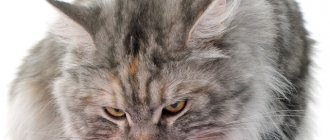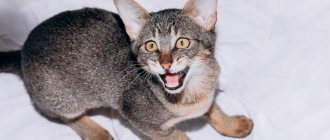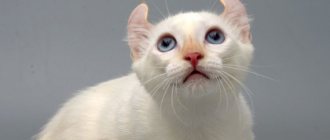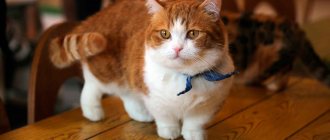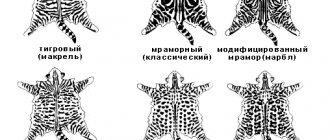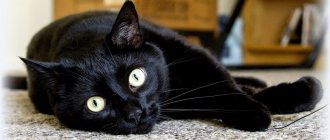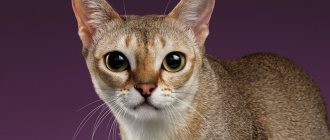By what characteristics is a cat classified as wild?
Non-domesticated felines are distributed throughout the world. They are all ideal predators. No other mammals on earth can sneak up, guard, and grab so skillfully.
What, then, is the difference between domestic pets and free savages? A wild cat differs from a domestic cat in the following features:
Temminka
- Color. A pattern in the form of stripes or spots helps animals remain unnoticed where they live. Desert inhabitants are close in color to sand, steppe inhabitants are close to dry grass.
- Size. Forest and steppe "pussies" differ from domestic purrs in height and body length, because they need strength to hunt.
- Short intestine. Their intestines are short because they need to move quickly, and a full belly prevents this.
- Length of limbs. Forest and steppe animals are forced to run a lot and quickly, domestic cats move little, which is why the latter have shorter legs. Savages have 5 toes on their front paws and 4 on their hind paws.
- Temper. Wild cats are distinguished by their ferocity and uncontrollability. They are nocturnal, try to avoid meeting people, and can attack him.
Cheetah An adult cat living freely in the forest or steppe is almost impossible to tame. You can only make a pet a small kitten that came to people as a baby, but in this case you should not forget that this is a predatory animal.
Bengal tiger
The royal representative of the panther genus, the Bengal tiger, lives in India, Nepal, Bangladesh, Pakistan and China. In Russia its population is 5 individuals. The predatory mammal is one of the largest cats in the world. The height of the tropical forest resident reaches 115 cm, weight - 275 kg. A terrifying roar can be heard at a distance of 3 km. The deadly fangs grow up to 10 cm. The record weight of a male killed in an Indian forest in 1967 was 388.7 kg.
Among the Bengal tigers there are amazing creatures whose snow-white fur is covered with brown stripes. All white individuals have one ancestor - the male Mohan, who was born in 1951 as a result of a gene mutation.
Reproduction and care of offspring
Steppe cats prefer to lead a solitary lifestyle . Each male has his own territory, which he jealously guards from the invasion of other cats. The females also help guard the territory, settling not far from the males, and, if necessary, join their efforts to drive away the strangers.
The mating season for these animals lasts from January to March. Interestingly, unlike domestic cats, steppe cats are rather quiet creatures and try not to attract attention by screaming and meowing. Only during the mating season, these cats can make different sounds, from loud meows to snorting and growling.
A female ready for mating can be courted by several males, and she chooses the largest and healthiest male as the father for future offspring. After courtship and mating, the male leaves the female and does not take any part in raising future offspring.
The pregnancy of a steppe cat lasts from two to two and a half months. As a nest, the female builds a hole or hollow in a tree. Young females give birth to one or two babies, while more mature individuals have up to six kittens in a litter. But most often, steppe cats give birth to no more than three babies. Kittens are born blind and helpless, and for the first six months they are completely dependent on the care of their mother.
Steppe cats have a highly developed maternal instinct, and they never abandon their offspring. Two weeks after birth, the kittens' eyes open, and a month later, the babies are already covered with fur and look like a smaller copy of their parents.
The female feeds the cubs with milk for more than two months, and only after this period has passed does she begin to accustom the kittens to adult food. First, the steppe cat brings the kids small rodents caught during the hunt. As the kittens grow older, the female brings live prey to her “nest,” teaching the cubs to hunt on their own.
For two to three months, steppe cat kittens do not leave the parental den; after this period, the cubs begin to go hunting with their mother. The steppe cat takes care of its babies for six to seven months, then the matured kittens begin an independent life. Sexual maturity of steppe cats occurs a year after birth, but usually, males are ready to breed only at the age of two.
The image of the black panther in human culture
The graceful, coal-colored predator has long attracted people's attention. The image of this beast can be found on the aristocratic coats of arms of the most glorious European monarchs. German heraldists preferred to use modified images, adding horns, cow ears, and a fiery tongue.
Our contemporaries associate the image of a black panther with Bagheera from Kipling's The Jungle Book.
Numerous dream interpreters offer the following interpretations of the appearance of a predatory cat in a dream plot:
- An animal proudly walking through the forest is the fulfillment of ambitious plans.
- A predator climbing a tree is a career failure.
- Hunting scene - quarrel with friends.
- A female with babies is a chance meeting with an interesting person.
- A predator caught in a cage is the fulfillment of a plan.
- A large animal means an enemy, and the coal color indicates that the enemy has influential support.
- A battle in which the predator wins means failure in business.
- A battle in which a man defeats a beast is success in his endeavors.
- A tamed and affectionate panther is a significant success and an increase in authority.
- Feeding a predator from your hands means support from high authorities.
Modern classification of wild cats
Once upon a time, all cats were divided into three subgroups. Nowadays, zoologists divide wild cat families into large and small cats. Previously, the cheetah subfamily was distinguished, but then, as a result of a study of the DNA of these animals, it was determined that they are close to small cats. Each subfamily contains several genera, which differ in habitat, size, color, and habits.
Subfamily of small cats
This group of mammals is divided into 12 genera and almost 30 different species. A distinctive feature of representatives of this subfamily is the ability to rumble when inhaling and exhaling. Representatives of some species can reach two meters in length.
Small cats have enviable eyesight, excellent hearing and a good sense of smell. These predators feed on small mammals, such as rodents, and birds.
Cheetah and caracal
Cheetahs are the fastest cats in the world: they can reach speeds of up to 120 km/h. True, an animal can run so fast for only a couple of minutes. This type of cat has a long body - about 140 cm. The color is sandy with characteristic spots.
Caracal
Caracal, or, as it is also called, steppe lynx. The body length of this animal can reach up to 82 cm. Distinctive features of the caracal are the presence of tassels on the ears, as well as hair brushes on the paws. It is very agile and can jump deftly.
Clouded leopard
Clouded leopards are excellent tree climbers. (Image credit: Arun Roysri/Getty Images)
According to the Smithsonian National Zoological Park, clouded leopards (Neofelis nebulosa) are not leopards (Panthera pardus), as their common name suggests, but a separate species of cat. They are smaller than leopards and other big cats. According to the San Diego Zoo, clouded leopards can grow up to 1 meter in length and weigh up to 25 kg. (, )
The clouded leopard population ranges from Nepal through Southeast Asia to China. However, according to the International Union for Conservation of Nature (IUCN), their population is fragmented and declining due to human activities such as deforestation and illegal hunting. They eat a variety of prey, including slow lorises (a type of small primate) and small deer. ()
Manul
Pallas's cat (Otocolobus manul, Pallas's cat) belongs to the subspecies of small cats and is included in the Red Book because it is an endangered animal. The beautiful thick fur of this predator (up to 7 cm in length) of gray or reddish-brown color with silver tips has made it a desirable prey for hunters for valuable fur. This fur saves animals from frost in their natural habitats. This species of feline hunts birds, hares, marmots, mice, badgers, lives for about 10 years, weighs about 5 kg with a length of 65 cm, and reproduces in the spring.
If you are seriously considering bringing a Pallas's cat into your home, check out the arguments against it:
- Manul is a nocturnal hunter, so he won’t let you sleep at night.
- This type of cat loves space; it is not suitable for keeping in an apartment; it needs a large yard.
- Sheds heavily.
- While playing and sharpening its claws, the animal will ruin all the furniture and curtains in the house.
- He has an aggressive character; neither other pets, nor you, nor your children will get mercy from him.
- It is unlikely that you will be able to find a cat to mate with, or vice versa, and the hormones playing in the spring will drive him into rage and severe aggression.
- Veterinary medicine is not very familiar with Pallas' cats, so in case of illness, it is unlikely that you will be able to find a veterinarian who can cure it.
- You will have to think carefully about the cat’s diet so that he does not get sick and develops properly; regular cat food will not suit him.
- This animal is listed in the Red Book, therefore it is not sold legally, and an illegally imported cat is very expensive (up to 6.5 thousand US dollars), may be infected with some disease or exhausted and exhausted.
There are several reviews on the Internet of people who have domesticated Pallas's cat, but they all note the evil nature of the animal.
Snow Leopard
To date, the number of snow leopards is unknown. The snow leopard, which lives far from people, is the most poorly studied representative of the feline tribe. The muscular wild cat is found in the mountainous regions of Central Asia and Southern Siberia at an altitude of 1.5–5 thousand m above sea level. Short, thick paws equipped with wide pads are adapted for walking on loose snow, and the ability to make 8-meter jumps helps to overcome deep crevasses.
The four-legged inhabitant of mountain peaks resembles a leopard in posture and size. The height of the male reaches 65 cm, weight - 55 kg. Fluffy gray-beige fur reliably protects from cold and camouflages in snowy gorges. A distinctive feature of the exterior is a meter-long thick tail, which the snow leopard uses as a rudder when running and jumping.
The largest wild cat
Liger Hercules Among the wild representatives of the cat family, lions and tigers are considered the largest. These predators can grow up to 250–280 kg. The most impressive size feline known to mankind is the liger Hercules. Ligers are hybrids obtained from lions and tigresses (hybrids - cubs of tigers and lionesses are called tigrolves). Hercules lives in Miami Park. Thanks to its size, the cat was included in the Guinness Book of Records. The weight of this giant is 408 kg.
Lion is the king of the animals
A dangerous predator who is not alien to nobility and greatness. The weight of a lion can reach 250 kg, and the height at the withers is about 123 cm. The length of the body ranges from 170 to 250 cm. In its structure, a lion is very similar to a tiger. Color varies from dark brown to sand. Lions are the only ones from the family of big wild cats to have a small tassel at the tip of their tail. Females differ from males not only in their smaller size, but also in the absence of a mane, the main decoration of a lion. It is not for nothing that he is called the gentleman of the world of predators. His proud, majestic demeanor and noble warning of the start of the hunt with a royal roar make one admire and admire this animal from afar.
They are the only ones from the family of big wild cats that do not live alone, but in peculiar families - prides. Typically, a pride includes females, cubs up to three years old and several males. The pride is led by a leader, an experienced and strong male. During the hunt, females usually serve as beaters, while males wait in ambush. It is almost impossible for an outside lion to get into the pride; an exception is made only in the case of a female vacancy. As a rule, the number of prides is the same and is regulated, obviously, depending on the food supply.
The lion's extant range is in Africa, with a small population in India.
Varieties
Today, three subspecies of this steppe cat are known:
- Siberian or nominal. It lives in the northern part of its range. Has a gray color.
- Central Asian, who lives in Afghanistan, Turkmenistan, and Northern Iran. Distinguished by red fur.
- Tibetan - with darker fur, black stripes on the tail and body and brighter spots on the head. Lives in Northern India, Northern Pakistan, Tibet, Kyrgyzstan, Uzbekistan.
Cheetah
Cheetahs can outrun any animal on land. (Image credit: Kerstin Meyer/Getty Images)
Cheetahs (Acinonyx jubatus) are the fastest land animals on Earth - they can reach speeds of up to 112 km/h. These are large cats, capable of growing up to 2.3 meters in length, including the tail. According to the Cheetah Conservation Foundation, cheetahs typically weigh between 34 and 57 kg. ()
Cheetahs are mainly found in northern, eastern and southern Africa. They are also found in Asia, but the species has almost disappeared there, with the exception of a small population in Iran. They typically eat small to medium sized prey, including gazelles.
European cheetahs once roamed the Earth and were much larger than modern cheetahs. In 2011, fossils were discovered at a 1.8-million-year-old site in Georgia belonging to an extinct species of cheetah called Acinonyx pardinensis, which was estimated to weigh about 110 kg.
Who is considered the smallest of the wild cats?
Rusty cat The smallest wild cat lives in Sri Lanka and South India. This breed is called a red or rusty cat. Kids prefer to stay close to trees all the time. Among the dense branches they find food for themselves - bird eggs, insects, chicks. The size of a miniature cat is only 80 cm including the tail. Red predators weigh no more than one and a half kilograms.
Lynx
The common lynx is the largest species of lynx. (Image credit: Javier Fernandez Sanchez/Getty Images)
Lynxes are wild cats with black tufts of fur on their ears and short tails. Found in North America, Europe and Asia. The bobcat (Lynx rufus) is the smallest of the four lynx species—only twice the size of a domestic cat—but other lynx can be much larger. The common lynx (Lynx lynx) is the largest species of lynx and can reach 1.3 meters in length and weigh up to 36 kg. Lynxes eat a variety of prey, including rodents, birds and deer. ()
Pampasskaya
This cat is also called the grass cat (Leopardus pajeros), lives in nature in the steppes of South America, is similar in size to its domestic relative, but looks larger. She has long hair (up to 7 cm) of gray, yellow or brown color, black or dark ears, a thick and long tail, and large ears.
Reasons why it is better not to keep her at home:
- The Pampas cat does not allow anyone into its territory.
- Leads a nocturnal lifestyle.
- Little studied.
- Prefers privacy.
- He steals all the birds from his neighbors.
- Doesn't adapt well to domestication.
- Listed in the International Red Book.
- The cost is about 1,000 US dollars.
Jaguar
This animal is often found in the tropical forests of Central and South America and is therefore the main competitor of the puma. Outwardly, it is very similar to a leopard, but its build is much heavier. An adult jaguar can reach 180 centimeters and weigh 100 kilograms. This makes him the largest cat on the American continent.
The most beautiful "savages" from the cat family
Jaguar The question of the most beautiful cat living freely in natural conditions is controversial, because all of these animals have an attractive appearance.
Photos of these predators are placed in nature magazines, on advertising posters, T-shirts, and on the covers of notebooks and notebooks. Spotted jaguars, rare American predators, unique black panthers, handsome tigers - these cats are found everywhere in the form of prints and in pictures. Share with friends!
What do they eat?
Cats are carnivorous animals; their main food is meat and protein. The large predator preys on artiodactyls and odd-toed ungulates, sometimes eating carrion. A leopard or lion can snack on a crocodile or reptile.
Small cats hunt rodents, hares, and rabbits. Cats living near water hunt for fish, frogs and small sea animals.
If there is a lack of water, they can eat fruits.
Position in the food chain
Felines occupy a place at the top of the food chain, they are carnivores. However, by eating prey - ungulates, hares, mice, birds along with skin, fur and stomach contents, cats receive ballast substances and plant fibers that improve digestion.
Interesting Facts
Many sites write about supposedly another breed of Chinese cats, Maneki-neko, a symbol that brings happiness. In fact, this figurine, which is often made of porcelain or ceramics, came from Japan, not the Middle Kingdom, and looks like a cat waving its paw. It is sold in souvenir shops and is believed to bring prosperity and happiness to the home.
The history of Maneki-neko began in the early 17th century, when one poor monk sheltered a wild mountain kitten dying of hunger. The temple in which the man lived was in a terrible state. One day, out of melancholy and hopelessness, the monk spoke to the animal, saying that he did not blame him for being useless, but if the cat were a person, he could be more useful.
The next day a thunderstorm broke out. A prince was driving past the monastery and saw a Chinese cat on the road waving its paw. The beast showed the way to the shelter, where the traveler found food and shelter. The next day, a wealthy guest allocated funds for the restoration of the monastery.
Since then, Maneki-neko has been in every home and it is believed that happiness and good luck always follow it.
Irbis
The snow leopard is not the largest cat, but it is the rarest. It is distinguished from other leopards by its lighter skin, which is often light gray rather than yellow. The snow leopard lives mainly in the Himalayan mountains, but only a few have been able to see this animal. This is partly because there are now just over 4,000 individuals left, making it listed as an endangered species. Its weight can reach 75 kilograms.
- INTERESTING:
Top 10 largest wild cats in the world
History of the species
Scientists believe that the Forest Cat appeared in the Pleistocene era, which began more than 2.5 billion years ago and ended 11.7 million years ago. Considering that humanity is only 2.8 billion years old, wild cats are at least 9 years older than humans.
The end of the Pleistocene era is characterized by an incredibly harsh climate. The planet had just experienced an ice age, the ice masses were retreating reluctantly, weather conditions also changed in waves - periods of sharp warming alternated with periods of the onset of very cold air masses. These processes served as an impetus for the transformation of flora and fauna. It was at this time that the woolly rhinoceros, mammoth, giant deer, cave lion and many other species appeared, most fully adapted to harsh climatic conditions.
With subsequent global warming, most animals of the glacial and post-glacial periods were unable to mutate and became extinct. The cat, which went into the shady forests and mountain ranges, managed to survive.
Thus, we can only talk about the approximate, latest date of the emergence of the European forest cat as a species - 11.7 million years ago. Although, most likely, this animal is older and has survived to this day since the Ice Age without any special changes.
The domestication of cats occurred much later, about 10 thousand years ago, when people began to lead a sedentary lifestyle, build homes, develop agricultural land and stockpile food.
Black Panther
Leopards and jaguars, whose skin is colored black due to a special combination of genes, are colloquially called black panthers. This coloration is not a species characteristic, but simply serves as a distinctive feature of individual individuals.
Appearance of panthers, what colors are they? The effect that leads to the appearance of the black pigment melanin on the fur of animals is called “melanism” and is a consequence of a gene mutation. If such a color helps the animal survive, the trait is passed on to subsequent generations. Incomplete melanism, resulting in the presence of dark-colored fragments on the animal skin, is called “abundism.”
Dark-colored leopards and jaguars have an advantage over their lighter-colored relatives when living in shady forest areas. Darkness provides reliable cover for the black-skinned predator and helps it sneak up on its intended prey unnoticed. By creating more favorable conditions for the survival of cats with dark colors, the environment helps to consolidate the traits in the offspring. Thus, among wild cats living in the jungles of Malaysia, black color is predominant. This characteristic first arose by chance, and then became established through the process of natural selection.
Representatives of the Jaguar and Leopard species, regardless of color, have skin that is replete with characteristic round spots - “rosettes”. Similar marks can be seen on the dark skin of melanistic animals. In cats with an incomplete form of melanism (abundism), the color of the skin resembles chocolate with varying degrees of saturation, and the rosettes are bluish-black.
Dark coloring is the only biological difference between black leopards and golden ones. All animals of this species can form pairs and give birth to offspring. The probability of birth of dark individuals is much less, since the melanism gene is of a recessive type.
Abundant cubs appear more often in representatives of the Leopard species. Sometimes the effect of incomplete melanism manifests itself in an increase in the number and size of rosette spots. This phenomenon is not always genetically determined. The color of the baby can be affected by natural factors that affected the pregnant female, for example, air temperature.
Photo of a black panther in the wild
